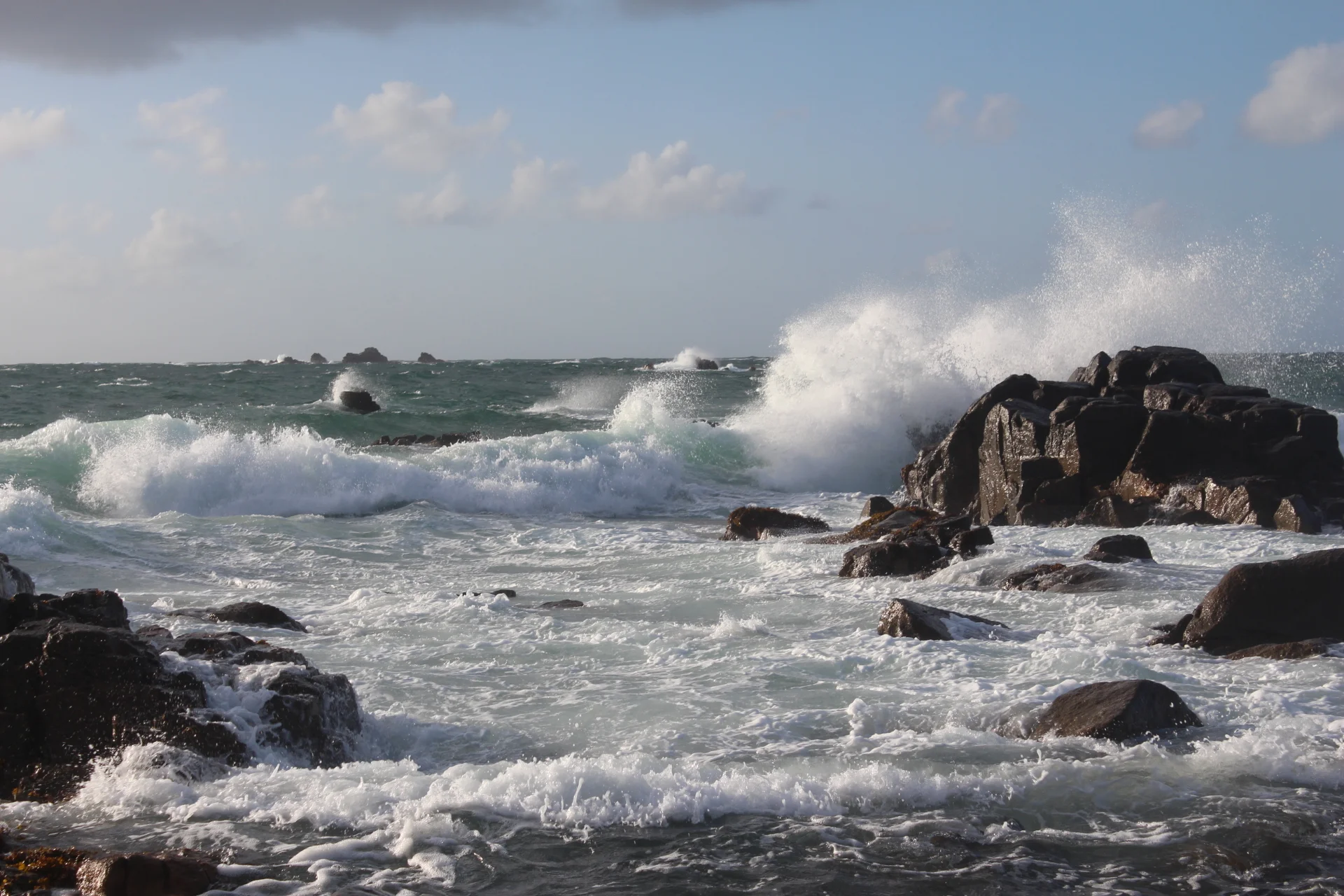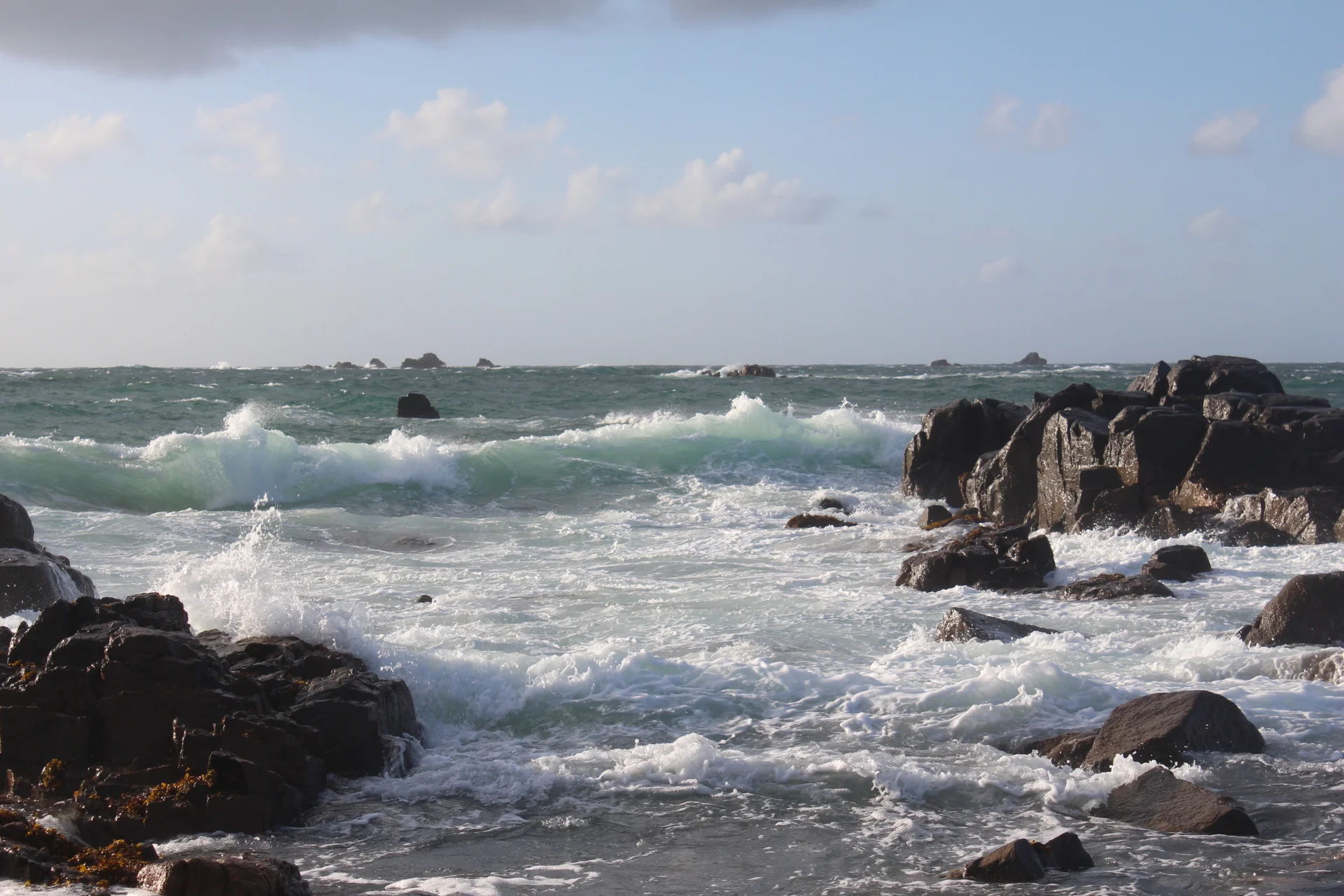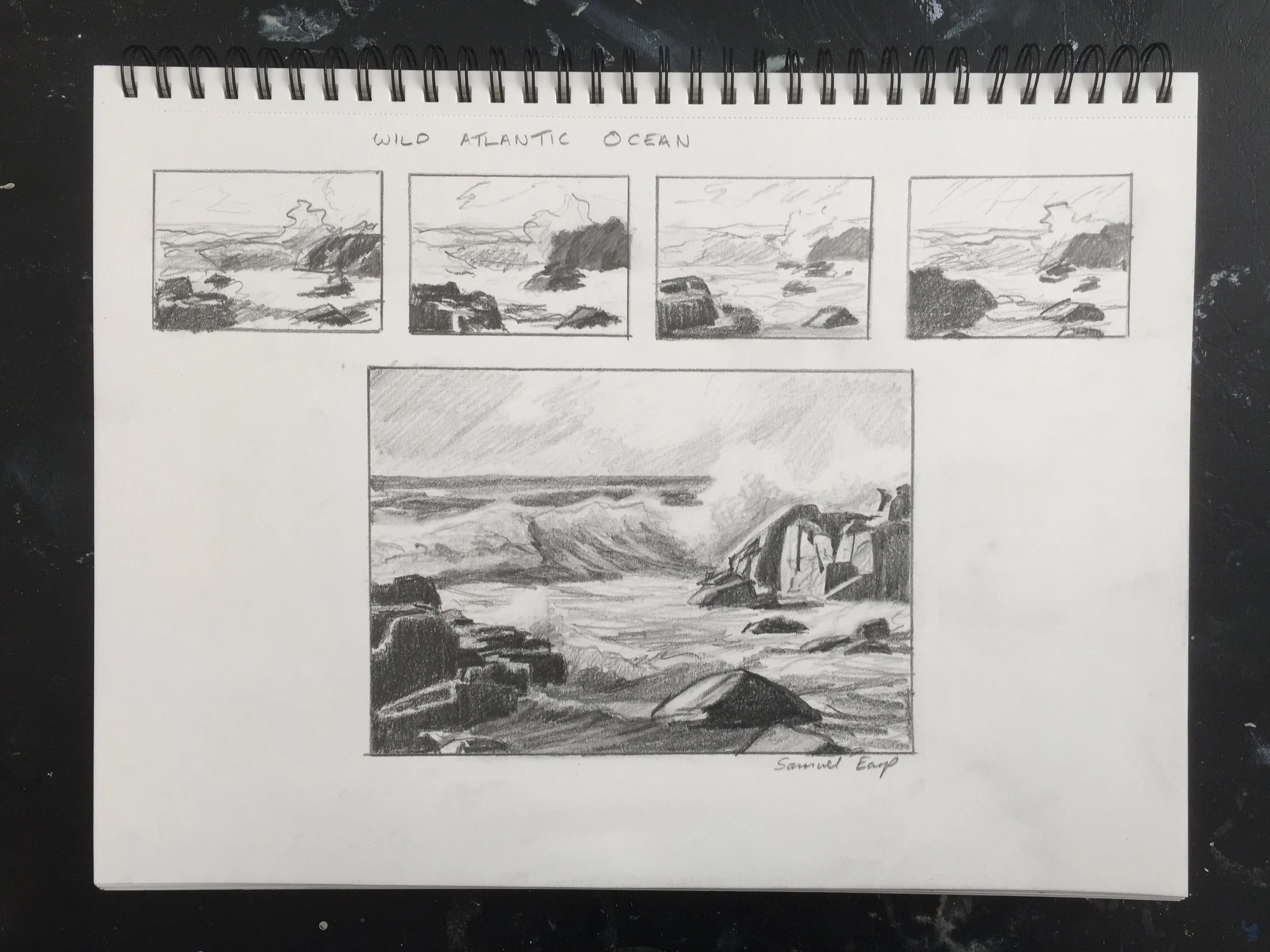How To Paint An Ocean Scene Step By Step
How to Paint a Dramatic Seascape in 5 Easy Steps

I dearest to paint the sea, in fact it's one of my favourite things to paint! In this blog post I will bear witness yous how to pigment this dramatic seascape in 5 easy stages.
1. CREATING THE COMPOSITION
This painting began with me taking photos from a place called Port Soif on the island of Guernsey, Uk. The ocean was crude and in that location was lots of light and atmosphere.
Port Soif is a swell identify for getting photo reference for seascapes, especially in the evening every bit the light is behinf the waves which means you go contrast between the shadows of the breaking waves simply sharp highlights in the wave crests and white water. These are all ingredients for ballsy seascape paintings!
These are ii of the photos I used to create this painting, feel free to re-create or use them.


So we accept a few ingredients here to create a dramatic seascape, the first is some large waves and heavy swells. We take light shining on the rocks and the back of the waves. Seascapes look very dramatic and are easier to paint when the lite is coming from behind and to the side of our subject field.
We have some jagged rocks, which always adds more than drama to a seascape especially when there are spills and water hitting the rocks causing foam bursts. And finally nosotros have shadows, this helps to add together more than drama to our painting by adding contrast between low-cal and nighttime and it helps to make the painting look more three dimensional.
Sketching
After I get my photo reference I sit down down with my sketch book and describe some modest thumbnails sketches which results in a last sketch which I refer to when painting my seascape. I would thoroughly recommend y'all do some sketches before y'all get in to a painting, information technology'll go far then much easier.

The composition I have created for this seascape is an 'Southward' composition, where the breaking wave is the focal indicate and the management of the rocks in the foreground leads the middle towards the moving ridge. The management of the clouds and so leads the eye across to the right to class an 'Southward' shape before leading the centre back down towards the rocks on the right.
The other rocks in the foreground too betoken in the direction of the breaking wave.


I utilise Langridge Handmade Oils and I'm using the following colours in the painting:
Titanium white
Yellow oxide
Burnt Sienna
Burnt Umber
Cadmium red lite
Quinacridone magenta
Ultramarine bluish
Cobalt blue
Cobalt teal
Pthalo green
2. BLOCKING IN THE PAINTING

I brainstorm my painting by sketching out the scene with titanium white mixed with quinacridone magenta and liquin which is a medium that thins the pigment and speeds upwards the drying.
You'll notice I am not painting on a white canvas, instead I previously applied a layer of burnt sienna which gives vibrancy to the painting as information technology comes through the paint layers.

I always begin by painting the heaven every bit this is the furthest abroad, I mix the colours in the heaven with cobalt blue, cobalt teal, a trivial ultramarine blue and titanium white.
For the clouds I pigment the highlights with pure titanium white, knowing that the shadow colours will mix in and that I'll be returning to it afterwards in the painting.
For the cloud shadows I mix ultramarine blue with burnt umber which knocks out the saturation of the blueish. I so add a picayune quinacridone magenta to tip the mixture on the violet side and then add titanium white to lighten the tone.
I pigment the horizon of the sea taking care to desaturate my blue mix and so it doesn't come forward in the painting.
Whenever y'all paint a seascape or indeed a mural become for either a high horizon or a low horizon, never in the middle of the painting as it is distracting to the composition.

I use pure titanium white to roughly marker the areas where the highlights of the waves and white water will go, again I am not worried it's come straight from the tube as it'll presently mix with the other shadow colours I an going to employ.
I paint the translucency of the wave by mixing cobalt teal, pthalo green and titanium white. Equally I paint the main body of the wave I start introducing cobalt blue and ultramarine blue. I also use the colours to roughly mark out the shadows in the foreground white water.

I pigment the shadows of the breaking waves past mixing ultramarine, cobalt blueish and titanium white.
I use my trio of blues for the body of water at the lesser of the painting and I also add a lilliputian quinacridone magenta and pthalo green to darken the tone.
I block in the shadows of the rocks by mixing burnt umber with ultramarine blueish which creates a nigh black.

To complete the blocking in stage I pigment the areas of the rocks that are in lite using a combination of burnt umber, burnt sienna, xanthous oxide and titanium white. I class the basic shapes with an ivory dagger brush.
With the blocking in stage complete I allow the painting to dry before beginning the side by side phase of the painting.
3. Edifice Upwardly THE DETAIL

So now that the painting is dry I start adding detail ton the heaven and clouds and refining their shapes. Many areas demand repainting and I use the colours in the sky that I used in the blocking in procedure.
I add more highlight into the clouds with titanium white only however dropping the tone a footling by mixing in a tiny amount of ultramarine blue, burnt umber and quinacridone magenta. Using a apartment bristle brush I add wispy bits to the cloud edges to make it look like turbulent cloud you lot go far bad weather.
Using a flat bristle brush I begin working on the areas of light on the wave crest, cream flare-up and white water. I am not using pure titanium white equally I need to keep the tone darker so I tin can pigment highlights and sparkles at the cease, and so I add a petty ultramarine blue, burnt umber and quinacridone magenta into the mix.

I starting time to add together highlights to the rocks by mixing burnt umber and titanium white to the mix. I ultimately want to give the illusion of moisture rocks.
I ascertain the shapes of the rocks in the foreground on the left side in grooming for adding more than details when they are dry out. I felt these rocks need to occupy more than space in the composition and so I made them bigger.
I introduce cream patterns in the breaking waves by mixing ultramarine blue, quinacridone magenta and titanium white. This is also the same colours I am using for the foamy water in the breaking wave.
4. REFINING THE PAINTING

At this stage of the painting I am refining the highlights in the white h2o in the foreground taking care not to make it completely white equally I still need to keep it tonally a little darker and so that when I add the highlights at the end with pure titanium white it volition really pop.
Using a dagger brush I pigment the shadows in the white water using the same colours I used in the shadow areas of the foam in the breaking moving ridge.
I paint the glistening water in the rocks on the right of the painting using titanium white with a tiny amount of burnt umber mixed with it.
Using an old fan brush where I had removed some of the beard with some scissors I paint h2o droplets in the foam burst on the right side of the painting.

Next, I focus on painting the reflect light on superlative of the rocks but also in a manner that gives the illusions that the rocks are wet. To exercise this I mix cobalt teal with quinacridone magenta and titanium white which creates a actually nice violet hue, I round of the mixture with cobalt blue and desaturate the mix a little past mixing in some burnt umber.
Using a dagger brush I mix ultramarine blueish with burnt umber and define the shape of the rocks in the foreground in grooming for calculation the areas in calorie-free. I brand marks to indicate cracks in the rocks.
5. Final DETAILS


4 Seascapes - Video Bundle
49.95
Cost is displayed in US dollars
iv Painting Tutorial Videos
-
Houghton Bay - Running Time: 57 minutes
-
Rocky Shore Seascape - Running Time: 60 minutes (approx)
-
Taupo Bay - Running Fourth dimension: 60 minutes (approx)
-
Piha Beach Seascape - Running Time: 62 minutes
To complete this painting I add together sparkles and highlights to the white water and foam bursts in the sea by using pure titanium white directly from the tube. Every bit this is my lightest tone in the whole painting, it pops when juxtaposed against anything behind that is darker.
I focus my attending on adding the terminal details to the rocks in the foreground, painting the reflected light in the shadow areas using the same colours I used in my other rocks to create the illusion of moisture rocks.
Using burnt umber mixed with titanium white and a piddling yellowish oxide I paint the areas of the rocks that are in full sunlight and then add pure titanium to requite the illusion of glistening wet rocks.
I give the illusion of a little heat in the shadow areas of the rocks by mixing burnt umber, quinacridone magenta and a niggling cadmium ruby-red low-cal.
I consummate the painting by adding spills on the rocks, something which e'er adds more drama to a seascape.
YOUTUBE VIDEO
Check out the painting video that accompanies this blog.
Featured
Source: https://www.samuelearp.com/new-blog/2017/11/12/how-to-paint-a-dramatic-seascape-in-5-easy-steps
Posted by: keyyouts1951.blogspot.com












0 Response to "How To Paint An Ocean Scene Step By Step"
Post a Comment